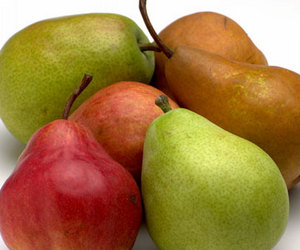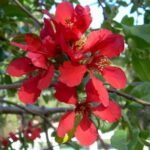The ancient Greek poet, Homer, called the pear “a gift from the gods” and I would have to agree with him. Biting into a tree ripened pear and have the sweet juice run down your chin and the mellow champagne taste of sweet pear in your mouth is heavenly, straight from the gods themselves.
A brief history of the cultivation of pears
Pears, (Pyrus Communis) are members of the rose family and related obviously to the apple and the quince. Horticultural historians believe that the pear was first cultivated in the South Caucasus, Northern Persia and in the Middle East, spreading up into Greece and Europe. Dried and cultivated slices have even been discovered in cave dwellings from the Ice Age in Switzerland.
When Americans think of pears, the name that most often comes to mind is Bartlett, but there are thousands of varieties of pears that have been cultivated and bred through the generations since Homer. The beloved pear of the Greeks became the favorite fruit of the Romans and spread throughout Europe and Asia. Transported to the New World by pioneers and colonists, pear orchards flourished and reached a peak of popularity in the late 1800’s when the British Horticultural Society claimed to have 627 different pear trees growing in its gardens.
We are preparing to plant a pear and apple orchard and have been researching breeds of both fruit trees. This research process has yielded many a fascinating harvest of pear information, trivia, history and horticultural delight. I think I’ve perhaps caught the pear fever that enraptured the world from the period of time between the 1600’s to late 1800’s when every prosperous citizen could converse and share their love and preference for their favorite pear.
For small hobby farm enthusiasts the heritage or heirloom pear offers the grower a hardy fruit tree that bears prodigiously, resists disease and is easy to care and maintain. Pear trees have been known to thrive and survive for 300 years. The pear you plant today, may be like the two on my husband’s family farm. They were planted by his grandmother when she was a young bride, over a hundred years ago.
Heirloom varieties of pear in danger of extinction
Unfortunately the amazing varieties of heirloom pears available for the home orchard is under assault, as pear stocks are decreasing amid commercial growers emphasis on just a few varieties. Todd Kennedy writes at Ark of America, a seed and plant preservation society, and is urging small hobby farmers to cultivate pear stock to ensure its continued existence in the plant world.
Of the great pear country that once existed on Long Island, Boston back-county, BucksCounty and HudsonValley, perhaps not one thousandth still survives. It is a wonder that so many varieties of old American pears have survived to be grown at Corvallis, given the holocaust of American orchards.” – C. Todd Kennedy*
Those great collections of varieties built up and maintained by pear enthusiasts and horticultural societies have all but disappeared. Commercial growers focus their efforts on those few popular varieties that yield them the highest profit margin. There are efforts under way to preserve hundreds of heirloom pear stock and The National Clonal Repository has many of those in their collection. By going to Ark of Taste website you can see many of these breeds as well as check out the ones at the Repository.
For our pear orchard, we are seriously considering a red skinned pear called Vermont Beauty, a White Doyenne from France, a Bartlett, and a golden red Tyson breed.
The Tyson Pear was discovered growing wild in a farmer’s hedgerow in 1794 in Jenkintown, Pennyslvania and soon became one of America’s favorite pears. While it does not produce fruit as large or pretty as its rival, the Bartlett, it is extra juicy, sweet and has an amazing aroma that one can only call, pear!
Where are we going to buy our heirloom pear trees? There are several good nurseries in the United States providing vintage heirloom pear stock. They are listed below with their websites if you’d like to take a journey down a pear filled lane.
Where to find heirloom pear tree starts
Cummins Nursery
www.cumminsnursery.com
Trees of Antiquity
www.treesofantiquity.com
Raintree Nursery
www.raintreenursery.com
Jung Quality Seeds
www.jungseed.com
One Green World
www.onegreenworld.com
It takes 2-4 years to harvest fruit from a pear tree stock brought from a nursery; five to six if grown from see. So in about four years, I’ll be picking my first sweet, succulent, juicy, creamy Tyson pear. You need to plant two trees together for pollination, so find a spot in your yard for an heirloom pear tree and reap the harvest while doing your part to save a rare plant.






